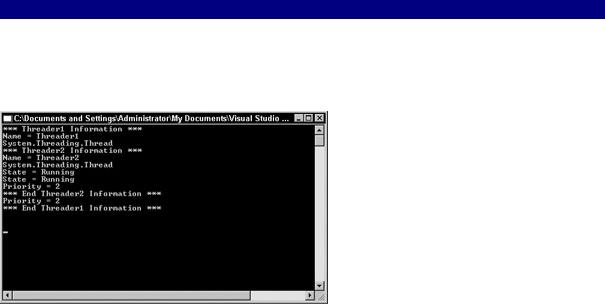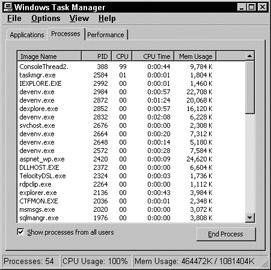
C# ПІДРУЧНИКИ / c# / Hungry Minds - C# Bible
.pdfall. The more memory you have, the more physical address space there is the running applications to create more threads. When you write applications that create threads, be sure you take this into consideration. The more threads you create, the more resources your application consumes. This could actually cause poorer performance than a single-threaded application, depending on the OS. The more the merrier does not include threads. Therefore, use caution when creating threads in that new version of multithreaded Tetris you are writing in C#.
Understanding application domains
Earlier, you learned that the MFC SDK defines a process as an executing instance of an application. Each application that is executing creates a new main thread, which lasts the lifetime of that application instance. Because each application is a process, each instance of an application must have process isolation. Two separate instances of Microsoft Word act independently of each other. When you click Spell Check, InstanceA of Word does not spellcheck the document running in InstanceB of Word. Even if InstanceA of Word attempts to pass a memory pointer to InstanceB of Word, InstanceB would not know what to do with it, or even know where to look for it, as memory pointers are only relative to the process in which they are running.
In the .NET Framework, application domains are used to provide security and application isolation for managed code. Several application domains can run on a single process, or thread, with the same protection that would exist if the applications were running on multiple processes. Overhead is reduced with this concept, as calls do not need to be marshaled across process boundaries if the applications need to share data. Conversely, a single application domain can run across multiple threads.
This is possible because of the way the CLR executes code. Once code is ready to execute, it has already gone through the process of verification by the JIT compiler. By passing this verification process, the code is guaranteed not to do invalid things, such as access memory it is not supposed to, causing a page fault. This concept of type-safe code ensures that your code does not violate any rules after the verifier has approved it passing from MSIL to PE code. In typical Win32 applications, there were no safeguards against one piece of code supplanting another piece of code, so each application needed process isolation. In .NET, because type safety is guaranteed, it is safe to run multiple applications from multiple providers within the same application domain.
Understanding the benefits of multithreaded applications
Several types of applications can take advantage of multithreading.
•Applications with long processes
•Polling and listener applications
•Applications with a Cancel button in the GUI
The following sections state the case for each of these reasons.
Applications with long processes
Applications that involve long processes with which the user does not need to interact can benefit from multithreading because the long-running process can be created on a worker thread that processes information in the background until a notification that the thread has completed is made to the process that called the thread. In the meantime, the user is not kept waiting, staring at an hourglass cursor, to move on to the next task.
Polling and listener applications
Polling applications and listener applications can benefit from multithreading. Suppose you have an application that has created threads that are listening or polling. When something happens, a thread can consume that particular event, and the other threads can continue to poll or listen for events to occur. An example of this is a service that listens for requests on a network port, or a polling application that checks the state of Microsoft Message Queue (MSMQ) for messages. An example of an off-the-shelf polling applications is Microsoft Biztalk Server. Biztalk is constantly polling for things like files in a directory, or files on an SMTP server. It cannot accomplish all of this on a single thread, so multiple threads poll different resources. Microsoft Message Queue has an add-on for Windows 2000 and a feature in Windows XP called Message Queue Triggers. With MSMQ Triggers, you can set properties that cause a trigger to fire an event. This is a multithreaded service that can handle thousands of simultaneous requests.
Cancel buttons
Any application that has a Cancel button on a form should follow this process:
1.Load and show the form modally.
2.Start the process that is occurring on a new thread.
3.Wait for the thread to complete.
4.Unload the form.
By following these steps, the click event of your Cancel button occurs if the user clicks the button while another thread is executing. If the user does click the Cancel button, it actually clicks, as the process is running on a thread other than the currently running thread handling the click event, your code should then stop the process on the other running thread. This is a GUI feature that turns a good application into a great application.
Creating Multithreaded Applications
Now it's time to begin creating multithreaded applications. Threading is handled through the System.Threading namespace. The common members of the Thread class that you use are listed in Table 33-1.
|
Table 33-1: Common Thread Class Members |
||
|
|
|
|
Member |
|
|
Description |
|
|
|
|
CurrentContext |
|
|
Returns the current context on which the thread is executing |
|
|
|
|
CurrentThread |
|
|
Returns a reference to the currently running thread |
|
|
|
|
ResetAbort |
|
|
Resets an abort request |
|
|
|
|
Sleep |
|
|
Suspends the current thread for a specified length of time |
|
|
|
|

|
Table 33-1: Common Thread Class Members |
||
|
|
|
|
Member |
|
|
Description |
|
|
|
|
ApartmentState |
|
|
Gets or sets the apartment state of the thread |
|
|
|
|
IsAlive |
|
|
Gets a value that indicates whether the thread has been started and |
|
|
|
is not dead |
|
|
|
|
IsBackground |
|
|
Gets or sets a value indicating whether the thread is a background |
|
|
|
thread |
|
|
|
|
Name |
|
|
Gets or sets the name of the thread |
|
|
|
|
Priority |
|
|
Gets or sets the thread priority |
|
|
|
|
Threadstate |
|
|
Gets the state of the thread |
|
|
|
|
Abort |
|
|
Raises the ThreadAbortException, which can end the thread |
|
|
|
|
Interrupt |
|
|
Interrupts a thread that is in the WaitSleepJoin thread state |
|
|
|
|
Join |
|
|
Waits for a thread |
|
|
|
|
Resume |
|
|
Resumes a thread that has been suspended |
|
|
|
|
Start |
|
|
Begins the thread execution |
|
|
|
|
Suspend |
|
|
Suspends the thread |
|
|
|
|
Creating new threads
Creating a variable of the System.Threading.Thread type enables you to create a new thread to start working with. Because the concept of threading involves the independent execution of another task, the Thread constructor requires the address of a procedure that will do the work for the thread you are creating. The ThreadStart delegate is the only parameter the constructor needs to begin using the thread.
To test this code, create a new project with the Console application template. The code in Listing 33-1 creates two new threads and calls the Start method of the Thread class to get the thread running.
Listing 33-1: Creating New Threads
using System;
using System.Threading;
public class Threads
{
public void Threader1()
{
}
public void Threader2()
{
}
}
public class ThreadTest

{
public static int Main(String[] args)
{
Threads testThreading = new Threads();
Thread t1 = new
Thread(new ThreadStart(testThreading.Threader1)); t1.Start();
Thread t2 = new
Thread(new ThreadStart(testThreading.Threader2)); t2.Start();
Console.ReadLine(); return 0;
}
}
When you create a variable of type thread, the procedure that handles the thread must exist for the ThreadStart delegate. If it does not, an error occurs and your application does not compile.
The Name property sets or retrieves the name of a thread. This enables you to use a meaningful name instead of an address or hash code to reference the running threads. This is useful when using the debugging features of Visual Studio .NET. In the debugging toolbar, a drop-down list of the names of the running threads is available. Although you cannot "step out" of a thread and jump into another thread with the debugger, it is useful to know on which thread an error may have occurred.
Now that the thread variables are declared, named, and started, you need to do something on the threads you have created. The procedure names that were passed to the thread constructor were called Threader1 and Threader2. You can now add some code to these methods to see how they act. Your code should now look something like Listing 33-2.
Listing 33-2: Retreiving Information on Runnnig Threads
using System;
using System.Threading;
public class Threads
{
public void Threader1()
{
Console.WriteLine (" *** Threader1 Information ***");
Console.WriteLine
("Name: " + Thread.CurrentThread.Name); Console.WriteLine
(Thread.CurrentThread);
Console.WriteLine
("State: " + Thread.CurrentThread.ThreadState); Console.WriteLine
("Priority: " + Thread.CurrentThread.Priority); Console.WriteLine(" *** End Threader1 Information ***");
}

public void Threader2()
{
Console.WriteLine (" *** Threader2 Information ***");
Console.WriteLine
("Name: " + Thread.CurrentThread.Name); Console.WriteLine
(Thread.CurrentThread);
Console.WriteLine
("State: " + Thread.CurrentThread.ThreadState); Console.WriteLine
("Priority: " + Thread.CurrentThread.Priority); Console.WriteLine(" *** End Threader2 Information ***");
}
}
public class ThreadTest
{
public static int Main(String[] args)
{
Threads testThreading = new Threads();
Thread t1 = new
Thread(new ThreadStart(testThreading.Threader1)); t1.Name = "Threader1";
t1.Start();
Thread t2 = new
Thread(new ThreadStart(testThreading.Threader2)); t2.Name = "Threader2";
t2.Start();
Console.ReadLine(); return 0;
}
}
When you run the application, your console output should look something like that shown in Figure 33-2.
Figure 33-2: Threading application output


threads are being processed by the operating system. This state might be useful to you in your application. Based on the state of a thread, you could determine that something else might need to be processed. Besides Start, the most common thread states you will use are Sleep and Abort. By passing a number of milliseconds to the Sleep constructor, you are instructing the thread to give up the remainder of its time slice. Calling the Abort method stops the execution of the thread. Listing 33-3 shows some code that uses both Sleep and Abort.
Listing 33-3: Using the Thread.Sleep Method
using System;
using System.Threading;
public class Threads
{
public void Threader1()
{
for(int intX = 0; intX < 50;intX ++)
{
if(intX == 5){ Thread.Sleep(500);
Console.WriteLine("Thread1 Sleeping");}
}
}
public void Threader2()
{
for(int intX = 0; intX < 50;intX ++)
{
if(intX == 5){ Thread.Sleep(500);
Console.WriteLine("Thread2 Sleeping");}
}
}
}
public class ThreadTest
{
public static int Main(String[] args)
{
Threads testThreading = new Threads();
Thread t1 = new
Thread(new ThreadStart(testThreading.Threader1)); t1.Priority = ThreadPriority.Highest;
t1.Start();
Thread t2 = new
Thread(new ThreadStart(testThreading.Threader2)); t2.Start();
Console.ReadLine(); return 0;
}
}

If you notice, the Priority property is set to highest for the t1 thread. This means that no matter what, it executes before t2 starts. However, in the Threader1 procedure, you have the following if block:
for(int intX = 0; intX < 50;intX ++)
{
if(intX == 5){ Thread.Sleep(500);
Console.WriteLine("Thread2 Sleeping");}
}
This tells the t1 thread to sleep for 500 milliseconds, giving up its current time slice and allowing the t2 thread to begin. After both threads are complete, the Abort method is called, and the threads are killed.
The Thread.Suspend method calls suspend a thread, indefinitely, until another thread wakes it back up. If you ever noticed the processor meter in the task manager spike at 100 percent when you aren't losing any memory, you can understand what happens when a thread is suspended. To get the thread back on track, you need to call the Resume method from another thread so it can restart itself. The following code demonstrates Suspend and Resume methods:
Thread.CurrentThread.Suspend;
Console.WriteLine("Thread1 Suspended");
Thread.CurrentThread.Resume;
Console.WriteLine("Thread1 Resumed");
A big caution is in order here: Suspending threads can cause undesirable results. You must ensure that the thread is resumed by another thread. Figure 33-4 demonstrates the issues described in the preceding paragraph. Notice in the figure that the console window is at the T1 Suspended line of code. This example reflects a test case, so you can get rid of the Resume method. The task manager results speak for the state of the system.
Figure 33-4: Spiked processor from a suspended thread
ThreadState is a bitwise combination of the FlagsAttribute enumeration. At any given time, a thread can be in more than one state. For example, if a thread is a background thread, and it is

currently running, then the state would be both Running and Background. Table 33-2 describes the possible states a thread can be in.
|
Table 33-2: ThreadState Members |
|
|
|
|
Member |
|
Description |
|
|
|
Aborted |
|
The thread has aborted. |
|
|
|
AbortRequested |
|
A request has been made to abort a thread. |
|
|
|
Background |
|
The thread is executing as a backgroung thread. |
|
|
|
Running |
|
The thread is being executed. |
|
|
|
Suspended |
|
The thread has been suspended. |
|
|
|
SuspendRequested |
|
The thread is being requested to suspend. |
|
|
|
Unstarted |
|
The thread has not been started. |
|
|
|
WatSleepJoin |
|
The thread is blocked on a call to Wait, Sleep, or Join. |
|
|
|
Joining threads |
|
|
The Thread.Join method waits for a thread to finish before continuing processing. This is useful if you create several threads that are supposed to accomplish a certain task, but before you want the foreground application to continue, you need to ensure that all of the threads you created were completed. In the following code, switch
T2.Join();
with
Console.Writeline("Writing");
You get two sets of results, the second time you run the code. The console output of Writing does not show up until both threads have finished.
Listing 33-4: Joining Threads
using System;
using System.Threading;
public class Threads
{
public void Threader1()
{
for(int intX = 0; intX < 50;intX ++)
{
if(intX == 5)
{
Thread.Sleep(500); Console.WriteLine("Thread1 Sleeping");
}
}
}
public void Threader2()
{

for(int intX = 0; intX < 50;intX ++)
{
if(intX == 5)
{
Thread.Sleep(500); Console.WriteLine("Thread2 Sleeping");
}
}
}
}
public class ThreadTest
{
public static int Main(String[] args)
{
Threads testThreading = new Threads();
Thread t2 = new
Thread(new ThreadStart(testThreading.Threader2)); t2.Start();
Thread t1 = new
Thread(new ThreadStart(testThreading.Threader1)); t1.Priority = ThreadPriority.Highest;
t1.Start();
/* Call Join to wait for all threads to complete */
t2.Join();
Console.WriteLine("Writing");
Console.ReadLine(); return 0;
}
}
As you can see, setting various properties on threads makes it very simple to control them. Keep in mind that after you suspend a thread, you need to resume it, or your system consumes unnecessary resources.
Synchronizing threads
Data synchronization is a critical aspect of using threads. Although it is not a complex programming task, your data risks corruption if you fail to address it.
When threads are running, they are sharing time with other running threads. This is evident in the sample you have run in this chapter. If you have a method that is running on multiple threads, each thread has only several milliseconds of processor time before the operating system preempts the thread to give another thread time in the same method. If you are in the middle of a math statement, or in the middle on concatenating a name, your thread could very
